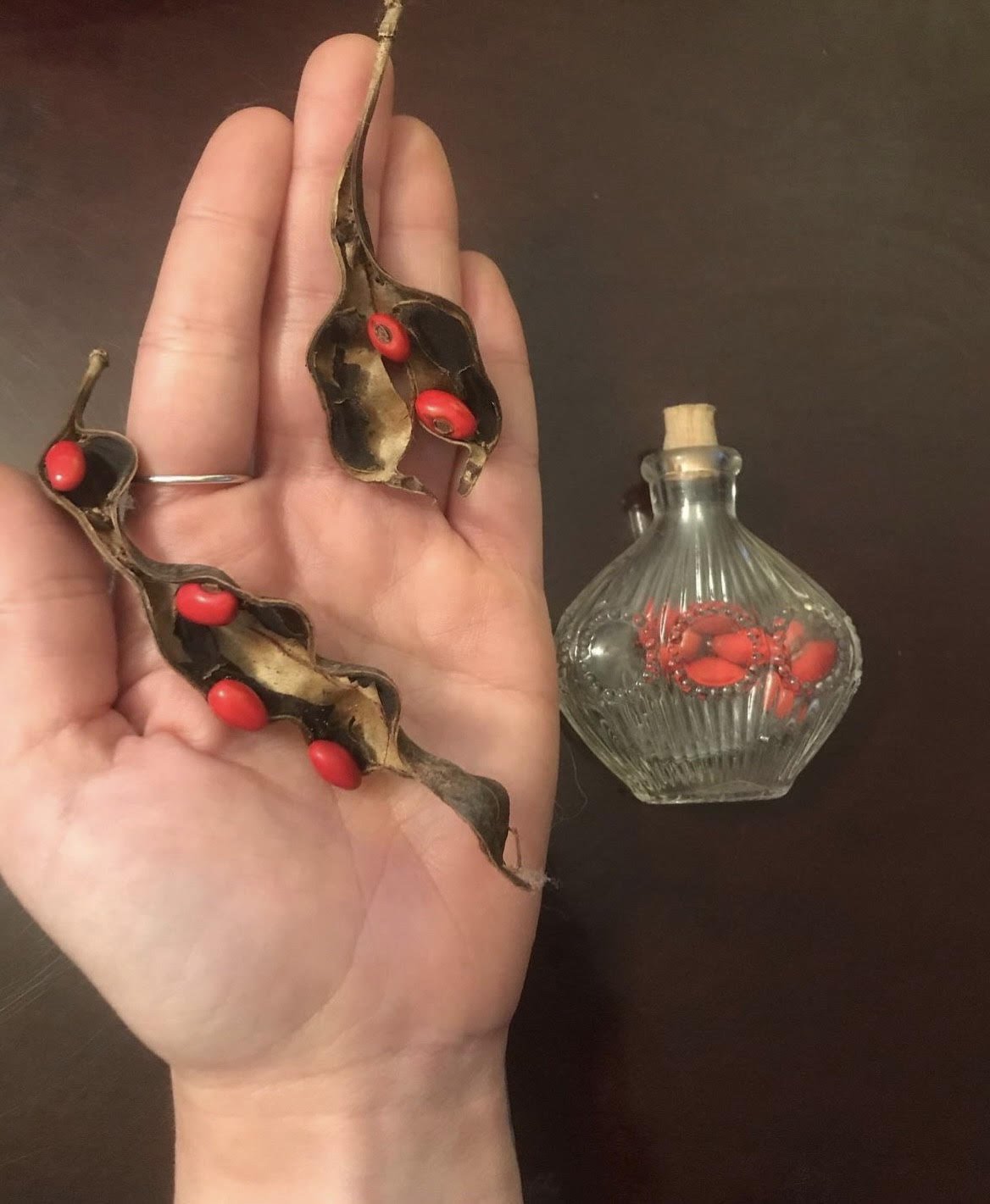Mamou/Coral Bean
Written by Carmin Nezat
Mamou/Cherokee Bean/ Coral Bean, Erythrina herbacea
It’s theorized that this plant may have been introduced to South Louisiana by trade among the Mogollon culture and other Native Americans from AD 150 to AD 1400, and by the Apache Tribe in the 1800s (Perrin and Fuselier 2022).
It is a member of the Fabaceae (or pea) family.
Historically and in present-day Cajun culture, the seeds (graine de Mamou) and root of this plant are used to make a tea or syrup to treat symptoms of the flu, pneumonia, bronchitis, tuberculosis, colds, pleurisy, and whooping cough; a tea made from the leaves is also (considered to be) useful in treating most respiratory problems as well as fever and stomach cramps.
From “Herbal Healing Traditions of South Louisiana,” 2014. Ray Brassieur, Ph.D. Associate Prof. of Anthropology. Referencing Charles Bienvenu’s “The Negro-French Dialect of Saint Martin Parish,” 1933.
It is imperative, according to culture, that you use an odd number of Mamou seeds to make these remedies. The ingredients for said recipe--whiskey, honey, lemon, coffee-- often vary by family tradition (please watch short video at the conclusion of this blog). Three (3) is usually the number of seeds settled upon, which according to religion and culture is “the number of wholeness or completeness”, as in the Holy Trinity. “Three is the first number to have a beginning, a middle, and an end” (Perrin and Fuselier 2022)-- but it isn’t unusual for the number in a recipe to go as high as eleven (11). Anything over thirteen (13) is considered deadly (please continue reading for explanation.)
Mamou seeds in pod and jar
In the 1940’s, Louisiana State senator Dudley LeBlanc, creator of the famous health tonic “Hadacol,” crafted a cough tonic using Mamou called “Dixie Dew Mamou,” that was used as remedy for decades (Martin 2022.) The beans were used historically by Cajuns when making blood sausage after butchering hogs due to its anticoagulant effects (Martin 2022.)
“Dixie Dew” cough syrup (image from worthpoint.com/dixiedewcoughsyrup)
This plant is very hardy. It grows best in sandy soils and has moderate salt tolerance. It is found in open woods, forest clearings, prairie remnants of the coastal plain, and disturbed areas. It is a larval host plant for the Erythrina borer (Terastia meticulosalis) and a “preferred browse” for white tailed deer. Hummingbirds are very attracted to the red flowers. It is a cover for nectar bees and also useful for some butterfly and moth species.
Author’s grandmother with her Mamou plant
The Choctaw used a decoction of the leaves as a general tonic. They call these “Chilo’pîmtobét” or “spirit bean”; the leaves are boiled in water, the liquid is strained off and again boiled, the extract is taken as a general tonic. The Seminole used a decoction of roots or berries for “horse sickness” which is nausea, constipation and blocked urination and a decoction of the 'beans' as a body rub & steam for “deer sickness” which manifests as numb, painful limbs & joints. In the Creek/Seminole language, the words for “coral bean” are “itco intcastuage” and “i:cí:salâ:lî:.” The Alabama and Creek used a cold decoction of the root for women experiencing bowel pain.
The young leaves and flowers are ⚠️SAID TO BE SAFE⚠️ to eat if they are cooked previously. However, in sufficient quantities, the seeds can cause human death. ⚠️The plant itself contains alkaloids that have powerful narcotic and purgative effect, the seeds contain numerous toxic alkaloids, and have been used as a rat poison. This alkaloid affects the motor nerves and is quite dangerous; the seeds are used in Mexico as a poison for various animals.⚠️
Seed/bean pods with seeds/beans
The following video is the author’s grandmother demonstrating the family’s Mamou recipe for cough remedy. Click full-screen icon on video to view corresponding text.
⚠️ This information is for educational purposes. Do not attempt to use plants unfamiliar to you as a medicine or food, especially when there are noted hazards. Please always do accurate research, be cautious of any allergies you may have, and/or talk to your doctor about Herb-Drug-Interactions before consuming or using wild plants medicinally. Additionally, when foraging, be aware of any contamination from polluted soil, animal waste, herbicides or pesticides, do not EVER forage from roadsides due to both traffic hazards and certainty of roadway pollution.⚠️
Swanton, John R, 1928, Religious Beliefs and Medical Practices of the Creek Indians, SI-BAE Annual Report #42:473-672, page 666. BRIT - Native American Ethnobotany Database Erythrina herbacea
Bushnell, Jr., David I., 1909, The Choctaw of Bayou Lacomb, St. Tammany Parish, Louisiana, SI-BAE Bulletin #48, page 23. BRIT - Native American Ethnobotany Database Erythrina herbacea
Choctaw Medicinal Plants and Treatment | Access Genealogy
Sturtevant, William, 1954, The Mikasuki Seminole: Medical Beliefs and Practices, Yale University, PhD
Thesis, page 188. BRIT - Native American Ethnobotany Database Erythrina herbacea
Sturtevant, William, 1954, The Mikasuki Seminole: Medical Beliefs and Practices, Yale University, PhD Thesis, page 192. BRIT - Native American Ethnobotany Database Erythrina herbacea
Healers-Garden-Brochure-Web.pdf (netdna-ssl.com) Coral Bean, Mamou.
http://www.ces.ncsu.edu/depts/hort/consumer/poison/poison.htm ;
Erythrina herbacea - Useful Tropical Plants (theferns.info)
medicinal herbs: CARDINAL SPEAR - Erythrina herbacea (naturalmedicinalherbs.net)
Plants of Louisiana (usgs.gov) Erythrina herbacea.
https://digitalcommons.usf.edu/cgi/viewcontent.cgi?article=2664&context=etd&gathStatIcon=true
Martin, Corinne. Louisiana Herb Journal. Louisiana State University Press, Baton Rouge. 2022. P 142-145
Fuselier, Beverly, Perrin, Mary. Andrepont Publishing, LLC. Opelousas, La. 2022. P78-82.






